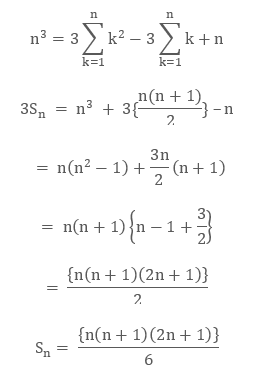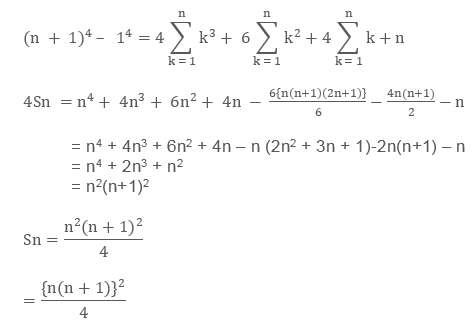Sum to n terms of Special Series
Table of contents |
Meaning of Series
The sum of all the numbers of the given sequence is called Series. It could be finite or infinite, like the sequences. It is written as Sn.
If the given sequence is 1, 3, 5, 7, …
Then the series will be 1 + 3 + 5 + 7 + …
And we will write it as
Sn = 1 + 3 + 5 + 7 + …
Types of Series
The different types of series are:
Arithmetic Series
The Arithmetic series is basically the sum of the terms of the arithmetic sequence that is, if the difference between the every successive term to its preceding term is always constant then it is said to be an arithmetic series.
Here we can see that we are getting the next term by adding the constant term that is, 3. So the first term is a = 2 and the common difference is d = 3.
The arithmetic series can be written in the form of
{a + (a + d) + (a + 2d) + (a + 3d) + .........}
where a is the first term of the series and d is the difference of it which is known as the Common Difference of the given series.
Formula of nth term of the Arithmetic Series
if we know that
a is the first term,
d is the difference and
n is the total number of the terms,
then the formula for the nth term will be
an = a + (n - 1) d
Sum of an Arithmetic Series
This is the arithmetic series with a = 1 , d = 1 and n = 5
Let’s find its sum with the formula

Example
Solve the Arithmetic Series to find the sum of the first 5 terms of the series.
Solution:
Given
a = 6 (first term of the series)
d = 2 ( common difference between the terms)
By putting the values in the formula

Geometric Series
The Geometric Series is basically the sum of the terms of the Geometric sequence that is, if the ratio between the every successive term to its preceding term is always constant then it is said to be a Geometric series.
Here we are getting the next term by multiplying a constant term that is, 1/2. So the first term is a = 1/2 and the common ratio is r = 1/2
Formula of nth term of the geometric series
In general, the geometric series is in the form of

Where, a is the first term of the series and r is the common ratio for it.
Formula for nth term of the geometric series
an = a1 r n - 1
Where, n is the number of the term.
Sum of geometric series

Example
What is the sum of the series
Solution:
First we have to check whether it is an arithmetic series or geometric series. As we can see that this is a geometric series because the ratio between every successive term is constant.
By putting the values, in the formula of the sum of the G.P.

Special Series
Special Series are the series which are special in some way. It could be arithmetic or geometric.
Some of the special series are:
(i) 1 + 2 + 3 +… + n (sum of first n natural numbers)
(ii) 12 + 22 + 32 +… + n2(sum of squares of the first n natural numbers)
(iii) 13 + 23 + 33 +… + n3(sum of cubes of the first n natural numbers).
Sum to n terms of Special Series
Let’s try to find the formula to find the sum of the above special series-
(i) Sn = 1 + 2 + 3 + 4 +… + n
Here we have to find the sum of the first n natural numbers.
This is an arithmetic progression as we can see
a = 1 and d = 1
The formula of the sum of the A.P. is

(ii) Sn = 12 + 22 + 32 +… + n2
Here we consider the identity
k3 - (k-1)3 = 3k2 - 3k +1
If we take the value of k as, k = 1, 2…, n
We get
13 – 03 = 3 (1)2 – 3 (1) + 1
23 – 13 = 3 (2)2 – 3 (2) + 1
33 – 23 = 3(3)2 – 3 (3) + 1
.......................................
.......................................
......................................
n3 – (n – 1)3 = 3 (n)2 – 3 (n) + 1
Now by adding both sides, we get
n3 – 03 = 3 (12 + 22 + 32 + ... + n2) – 3 (1 + 2 + 3 + ... + n) + n

(iii) Sn = 13 + 23 + 33 +… + n3
Here we consider the identity,
(k + 1)4 – k4 = 4k3 + 6k2 + 4k + 1
Now we will put the values of k as k = 1, 2, 3… n,
Then we get
24 – 14 = 4(1)3 + 6(1)2 + 4(1) + 1
34 – 24 = 4(2)3 + 6(2)2 + 4(2) + 1
44 – 34 = 4(3)3 + 6(3)2 + 4(3) + 1
..................................................
..................................................
..................................................
(n – 1)4 – (n – 2)4 = 4(n – 2)3 + 6(n – 2)2 + 4(n – 2) + 1
n4 – (n – 1)4 = 4(n – 1)3 + 6(n – 1)2 + 4(n – 1) + 1
(n + 1)4 – n4 = 4n3 + 6n2 + 4n + 1
Now add both sides,
We get
(n + 1)4 – 14 = 4(13 + 23 + 33 +...+ n3) + 6(12 + 22 + 32 + ...+ n2) + 4(1 + 2 + 3 +...+ n) + n

Finally, we get the formulas for the above three special series.

Example
Find the sum of first n terms of the series 1.3 + 3.5 + 5.7 + ...
Solution:
Let Sn = 1.3 + 3.5 + 5.7 + ...
Here the n th term of the series
t n = {n th term of 1, 3, 5, ...} × {n th term of 3, 5, 7,...}
= (2n – 1) (2n + 1) = 4n2 – 1

Example
Find the sum to n terms of the series 3 + 7 + 13 + 21 + 31 +…
Solution:
Let S = 3 + 7 + 13 + 21 + 31 +……..+ an-1 + an
S = 3 + 7 + 13 + 21 + 31+… + an-2 + an-1 + an
By subtracting the two equations , we get


More Readings




